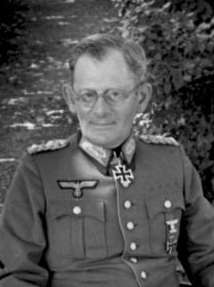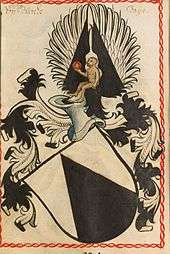Maximilian von Weichs
| Maximilian Reichsfreiherr von Weichs | |
|---|---|
 | |
| Born |
12 November 1881 Dessau, Duchy of Anhalt, German Empire |
| Died |
27 September 1954 (aged 72) Burg Rösberg near Bonn, North Rhine-Westphalia, West Germany |
| Allegiance |
|
| Service/branch | Heer |
| Years of service | 1900–45 |
| Rank | Generalfeldmarschall |
| Commands held |
1st Panzer Division XIII Corps 2nd Army Army Group B Army Group F |
| Battles/wars |
|
| Awards | Knight's Cross of the Iron Cross with Oak Leaves |
Maximilian Maria Joseph Karl Gabriel Lamoral Reichsfreiherr von und zu Weichs an der Glon (12 November 1881 – 27 September 1954) was a German field marshal during World War II. He was a recipient of the Knight's Cross of the Iron Cross with Oak Leaves. He commanded several armies and army groups, including the 2nd Army during Operation Barbarossa and Army Group B during the Battle of Stalingrad in 1943.
In 1944, Weichs commanded Army Group F in the Balkans directing operations against local partisan groups and then overseeing the German retreat from Greece and most of Yugoslavia. During the Nuremberg Trials, Weichs was implicated in war crimes and was scheduled to take part in the Hostages Trial. He was removed from the proceeding for medical reasons without having been judged or sentenced.
World War I

Born in 1881 into an aristocratic family, Maximilian von Weichs entered the Bavarian Cavalry in 1900 and fought in World War I. From 1915 until 1918 he served with the General Staff of the 3rd Bavarian Army Corps. After the war he remained in the newly created Reichswehr where he worked at a number of General Staff positions.
Transferred from the 3rd Cavalry Division to command Germany's 1st Panzer Division upon its formation in October 1935, he led the unit in maneuvers that impressed Army Commander in Chief Werner von Fritsch.[1] Weichs' aristocratic and cavalry credentials demonstrated the continuing influence of these military elites in Germany's modernizing force.[2] In October 1937 he became the commander of the 13th Army Corps, that later served in the 1938 German annexation of the Sudetenland.
World War II
For the German invasion of Poland beginning World War II in 1939, Weichs was appointed head of his own Army Corps "Weichs". After the Polish surrender, he was made Commander-in-Chief of the 2nd Army, a part of Rundstedt’s Army Group A in the West. After the Battle of France, he was awarded the Knight's Cross of the Iron Cross and promoted to colonel-general. Leading his corps, Weichs later took part in the Balkans Campaign, and in preparation for Operation Barbarossa, the German invasion of the Soviet Union, he was assigned to lead the 2nd Army as a part of Fedor von Bock’s Army Group Centre. He led the 2nd Army in 1941 through the Battle of Kiev, the Battle of Smolensk, and then on to Vyazma and Bryansk.
In 1942, for Fall Blau, Weichs was assigned to lead the newly created Army Group B.[3] Army Group B was composed of Salmuth's 2nd Army, Hoth’s 4th Panzer Army, and Paulus's 6th Army. In addition to the German armies, Army Group B included the 2nd Hungarian Army, 8th Italian Army, the Third and the Fourth Romanian Armies. The 6th Army was assigned to take the city of Stalingrad and cover approximately 800 km of front.
The Soviet Operation Uranus broke through the Romanian armies on his flanks, cutting off the 6th Army inside Stalingrad. Suggesting retreat, Weichs fell out of Hitler’s favor. Consequently, parts of Army Group B were taken away from the command of Weichs and incorporated into a new "Army Group Don", led by Manstein. Later in February, the remaining part merged with the Don Group into a newly reinstated Army Group South, also led by Manstein. Weichs was relieved of command.
Weichs was promoted to Generalfeldmarschall on 1 February 1943. In August 1943 Weichs was appointed Commander of Army Group F in the Balkans directing operations against local partisan groups. In late 1944, he oversaw the German retreat from Greece and most of Yugoslavia. Weichs was retired on 25 March 1945 and was arrested by American troops in May. During the Nuremberg Trials, Weichs was implicated in war crimes committed while suppressing the partisans. He was removed from the Hostages Trial for medical reasons without having been judged or sentenced.
Awards
- Knight's Cross of the Iron Cross with Oak Leaves
- Iron Cross of 1914
- Clasp to the Iron Cross of 1939
- Mentioned in the Wehrmachtbericht 8 times (11 April 1941; 6 August 1941; 7 August 1941; 23 September 1941; 18 October 1941; 19 October 1941; 10 September 1943; 19 January 1944)
- Generaloberst: 1 July 1940; Generalfeldmarschall—1 February 1943
References
Citations
Bibliography
- Goda, Norman (2005). "Black Marks: Hitler's Bribery of his Senior Officers During World War II". In Kreike, Emmanuel; Jordan, William Chester. Corrupt Histories. Toronto: Hushion House. pp. 96–137. ISBN 978-1-58046-173-3. Originally published as: Goda, Norman (June 2000). "Black Marks: Hitler's Bribery of his Senior Officers During World War II". The Journal of Modern History. 72 (2): 413–452. doi:10.1086/315994.
- Hürter, Johannes (2006). Hitlers Heerführer - Die deutschen Oberbefehlshaber im Krieg gegen die Sowjetunion 1941/42 (in German). München, Germany : Oldenbourg: Oldenbourg. ISBN 978-3-486-57982-6.
- Megargee, Geoffrey P. (2000). Inside Hitler's High Command. Lawrence, Kansas: Kansas University Press. ISBN 0-7006-1015-4.
- Scherzer, Veit (2007). Die Ritterkreuzträger 1939–1945 Die Inhaber des Ritterkreuzes des Eisernen Kreuzes 1939 von Heer, Luftwaffe, Kriegsmarine, Waffen-SS, Volkssturm sowie mit Deutschland verbündeter Streitkräfte nach den Unterlagen des Bundesarchives [The Knight's Cross Bearers 1939–1945 The Holders of the Knight's Cross of the Iron Cross 1939 by Army, Air Force, Navy, Waffen-SS, Volkssturm and Allied Forces with Germany According to the Documents of the Federal Archives] (in German). Jena, Germany: Scherzers Miltaer-Verlag. ISBN 978-3-938845-17-2.
- Showalter, Dennis E. (2009). Hitler's Panzers: The Lightning Attacks That Revolutionized Warfare. New York: Berkley. ISBN 978-0-425-23004-6.
- Stahel, David (2015). The Battle for Moscow. Cambridge, UK: Cambridge University Press. ISBN 978-1-107-08760-6.
- Thomas, Franz (1998). Die Eichenlaubträger 1939–1945 Band 2: L–Z [The Oak Leaves Bearers 1939–1945 Volume 2: L–Z] (in German). Osnabrück, Germany: Biblio-Verlag. ISBN 978-3-7648-2300-9.
| Military offices | ||
|---|---|---|
| Preceded by none |
Commander of 1st Panzer Division 1 October 1935 – 30 September 1937 |
Succeeded by Generalleutnant Rudolf Schmidt |
| Preceded by none |
Commander of XIII Army Corps 1 October 1937 – October 1939 |
Succeeded by Generaloberst Heinrich von Vietinghoff |
| Preceded by none |
Commander of 2nd Army 20 October 1939 – 13 July 1942 |
Succeeded by General Hans von Salmuth |
| Preceded by Generalfeldmarschall Fedor von Bock |
Commander of Army Group South July 1942 – 12 February 1943 |
Succeeded by Generaloberst Erich von Manstein |
| Preceded by none |
Commander of Army Group F (Belgrade) 26 August 1943 – 25 March 1945 |
Succeeded by none |
